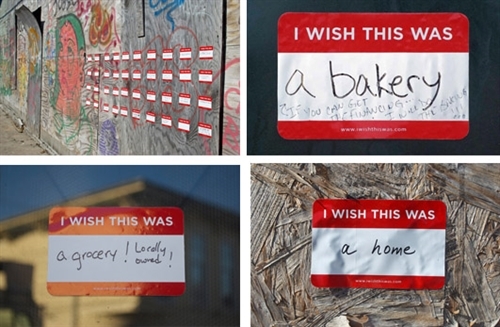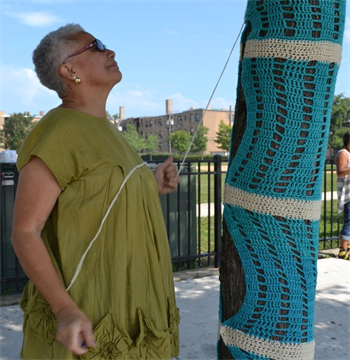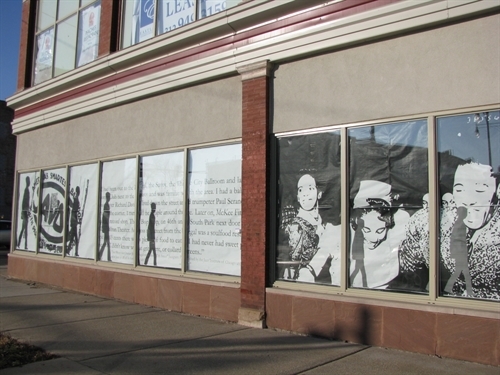
Photo courtesy of the Ladies Fancywork Society
Patience, I hear, is a virtue. I wouldn’t know; I am an impatient person by nature. While parenthood and living for a year in a Mediterranean country have done wonders to temper this, impatience remains intrinsic to my DNA. Lately I’ve been thinking, though, that maybe patience is overrated. As I live and work in some of the Chicago neighborhoods hit hardest by economic recession, I see the effects of our collective patience every day.
I see it reflected in our “all or nothing” focus: public funding and systems of recognition – like grand openings and awards – go toward the full realization of a space. Up and down the streets of our neighborhoods, it is clear that we view the use of space in one of two ways: its highest and best use, or nothing at all. That is, either a corner in North Lawndale becomes a newly constructed, multi-family affordable apartment building, or it stays a bunch of trash-strewn vacant lots.
It seems that most of us are content to wait for the ideal, but I keep thinking that maybe there’s another important place to focus our energy, creativity and funds: in the spaces that exist between the current state and the finished product. Why not embrace our impatient side, stop waiting, and explore what could exist in between these two poles? When lenders aren’t lending, when buyers aren’t buying, when tax credit investors can’t be found and the desired market doesn’t yet exist, the question becomes what do we do with our unused, underused, misused, abandoned, or under construction public spaces? What do we do, in other words, in the meantime?
Asking this question means acknowledging that in these tough economic times, the finished product may no longer be in sight for any given vacant lot or empty storefront. Particularly in communities that bore the brunt of the recession, the housing market remains oversupplied, lenders are still loathe to lend, and retailers are skittish. Let’s face it: The ideal may take awhile.
What would our communities look like if instead of turning our heads from the vacant eyesores and dilapidated fencing that dot so many of our communities, or passively waiting for investors and developers to feel comfortable in our neighborhoods again, we took it upon ourselves to embrace these spaces as transitional places? What if we deliberately sought out and created low-cost, temporary uses for these spaces? The web site TEMPLACE calls it “activity in spaces currently unsuitable or undesirable in mainstream economic cycles.” According to the web site No Vacancy!, this activity “can also catalyze the ‘creative economy’ by…act(ing) as laboratories and incubators for art, business, culture, and civic society by providing space for experimentation.”

Photo courtesy of Ladies Fancywork Society
For example, when Denver’s Union Station underwent a long-term redevelopment, the city issued an open call for artists to present ideas for livening up the massive construction fences that surrounded the site. A crew of knitters called the Ladies Fancywork Society received a small grant to “yarn bomb” the fence, turning it into a faux garden of crocheted flowers, butterflies and ladybugs that became a tourism draw in and of itself.

Photo Courtesy of the Denver Post
In post-Katrina New Orleans, artist Candy Chang turned the wall of a boarded-up house into an interactive public space through the use of a giant chalkboard. Passers-by were invited to use chalk to finish the sentence “Before I die, I want to…”

Photos Courtesy of Candy Chang
What if instead of just taking up space, vacant buildings were used as a canvas to interact with the desires of community members? Chang’s “I Wish This Was” project uses easily removable adhesive stickers to ask residents what they wish the building provided the community. As Chang’s website states, “It’s a fun, low-barrier tool to provide civic input onsite, and the responses reflect the hopes, dreams, and colorful imaginations of different neighborhoods.”

Photos Courtesy of Candy Chang
Examples abound closer to home as well. In Chicago’s Rogers Park neighborhood, members of the Rogers Park Business Alliance (RPBA) decided they were tired of passively waiting for new development and streetscaping to transform a struggling part of Howard Street. They asked themselves what they could control, what they could afford, and what they could do quickly. The result was one of the largest yarn bombings in the country as 35 knitters came together to create “sleeves” covering bike racks, electrical boxes, and trees. RPBA’s Executive Director Kimberly Bares describes the effort as part community development, part public art installation, and notes that in addition to the art drawing attention and energy to the area, the process itself was a great community builder, as several knit-ins were held in prominent parking spaces with food supplied by local eateries.

Photos Courtesy of the Rogers Park Business Alliance

In a recent exhibition entitled “The Future’s Past,” Bronzeville’s Blanc Gallery curated archival photos depicting the area’s rich cultural history and installed them not only in their gallery but in vacant storefronts of several historic buildings throughout the neighborhood. On opening night, a trolley took people on tours and local historians explained the stories behind the photos and the buildings in which they were installed. The exhibition is now over, but many of the installations remain in vacant storefronts throughout the community, such as in the corner windows of the historic Savoy building.

Photo Courtesy of Marisa Novara
Bronzeville has also historically been home to Chicago’s biggest concentration of public housing. Through the Chicago Housing Authority’s Plan for Transformation over the past 12 years, more than 10,000 units in the area were demolished to make way for new mixed-income communities. With the economic crisis and plummeting housing market of the past five years, however, much of the replacement housing has yet to be rebuilt, leaving large swaths of vacant land. This past summer MPC organized a task force focused on retail development in Bronzeville, during which community development guru Jim Capraro urged local stakeholders not to think of this empty space as an eyesore, but rather as an opportunity to capitalize on Bronzeville’s musical past. Why not, he asked, temporarily repurpose the vacant land as an outdoor music festival? Such a festival would go a long ways toward making Bronzeville a destination, a reason for many who have never done so to check out this historic community. Just recently, the City’s Dept. of Cultural Affairs and Special Events announced that it was doing exactly that: Two days of this summer’s Gospel Fest will take place on the site of the former Ida B. Wells public housing development on King Drive between 37th and 39th streets. Kudos to the Dept. of Cultural Affairs and Ald. Pat Dowell (3rd Ward ) for having the vision to turn this vacant land into a gospel mecca, while encouraging thousands of people to see what Bronzeville has to offer.
I read recently that impatience goes hand in hand with intensity. What if we embraced our intensity when it comes to our neighborhoods? What if we found lots and lots of lighter, quicker, cheaper means of transforming the spaces we inhabit on a daily basis? What if our vacant lots, empty storefronts, blank walls, and construction fences became the canvasses upon which we experiment and bit by bit create the neighborhoods we want?